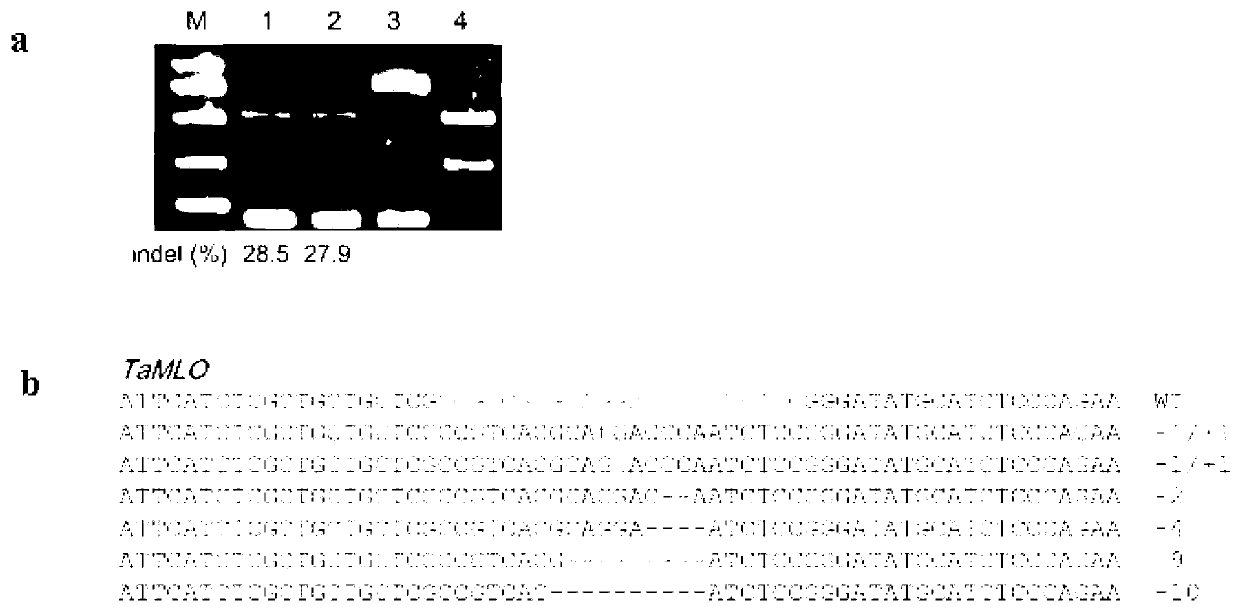Wheat genome site-specific modification method
A technology of genetic modification and wheat, applied in the field of plant genetic engineering, can solve the problems of time-consuming, labor-intensive, blindness, and high cost
- Summary
- Abstract
- Description
- Claims
- Application Information
AI Technical Summary
Problems solved by technology
Method used
Image
Examples
preparation example Construction
[0037] 1. Preparation of Cas9 nuclease recombinant expression vector
[0038] Streptococcus pyogenes Cas9 (SpCas9, S.pyogenes Cas9) gene was codon optimized, and nuclear localization signal (NLS) and BamH Ⅰ / Mfe Ⅰ restriction enzyme cutting sites were added at both ends of the gene coding sequence to optimize The latter Cas9 can be better expressed and localized in wheat. The nucleotide coding sequence of Cas9 after adding NLS and restriction sites at both ends and codon optimization is shown in SEQ ID No. 1 in the sequence listing. In SEQ ID No.: 1, positions 1-6 are BamH Ⅰ restriction sites, positions 4213-4218 are Mfe Ⅰ restriction sites, positions 10-36 are N-terminal NLS sequences, positions 4162-4209 are The C-terminal NLS sequence, the 37th-4161st position is the coding gene of Cas9 protein. The coding frame in SEQ ID №: 1 is nucleotide 7-4212 of SEQ ID №: 1, which encodes the protein shown in SEQ ID №: 2, which is the Cas9 nuclease with a nuclear localization signal p...
Embodiment 1
[0044] Example 1. Site-directed mutagenesis of the wheat endogenous gene TaMLO by gRNA: Cas9 system
[0045] (1) Design of target fragment target-SP6
[0046] target-SP6: G GAGATTGGGTCCTGCGTGA CGG ; (Genbank No is the 429th-451st nucleotide in the negative strand of the TaMLO gene of AF384144)
[0047] (2) Preparation of pU6-gRNA plasmid containing SP6 nucleotide fragment
[0048] SP6 is the coding DNA of RNA that can complementarily bind to the target target-SP6.
[0049] Synthesize the following single-stranded primers with sticky ends (underlined):
[0050] SP6-F: CTTG GAGATTGGGTCCTGCGTGA;
[0051] SP6-R: AAAC TCACGCAGGACCCAATCTC.
[0052] After the primer annealing procedure, double-stranded DNA with cohesive ends was formed and inserted between the two BbsI restriction sites of the pU6-gRNA plasmid to obtain the pU6-gRNA plasmid containing SP6. The positive plasmid was verified by sequencing.
[0053] (3) Transformation of gRNA: Cas9 system into wheat protopla...
PUM
 Login to View More
Login to View More Abstract
Description
Claims
Application Information
 Login to View More
Login to View More - R&D
- Intellectual Property
- Life Sciences
- Materials
- Tech Scout
- Unparalleled Data Quality
- Higher Quality Content
- 60% Fewer Hallucinations
Browse by: Latest US Patents, China's latest patents, Technical Efficacy Thesaurus, Application Domain, Technology Topic, Popular Technical Reports.
© 2025 PatSnap. All rights reserved.Legal|Privacy policy|Modern Slavery Act Transparency Statement|Sitemap|About US| Contact US: help@patsnap.com



